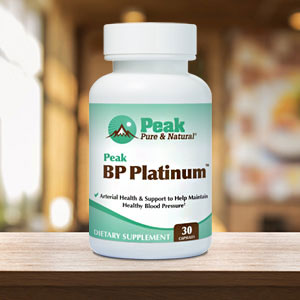Get Easy Health Digest™ in your inbox and don’t miss a thing when you subscribe today. Plus, get the free bonus report, Mother Nature’s Tips, Tricks and Remedies for Cholesterol, Blood Pressure & Blood Sugar as my way of saying welcome to the community!
How you can stop a stroke

Remember the old Smokey Bear ads about preventing forest fires?
The Smokey campaign was created in 1944 because forest fires were considered one of the most critical issues affecting the country.
The original Smokey slogan said, “Care will prevent 9 out of 10 forest fires.” After a couple of years, it was changed to the one we grew up with, “Remember … only YOU can prevent forest fires.”
So why are talking about Smokey Bear? Because there’s a new critical issue affecting Americans, and once again, only YOU can do something about it. I’m talking about stroke.
Strokes are preventable
Like forest fires, cardiovascular disease and strokes are among the most critical issues affecting the country, and in an amazing coincidence, a new study reveals that 9 out of 10 strokes are preventable.
Here’s a little bit of information that may help scare you straight: Nearly 800,000 people have a stroke every year putting it at the number 5 cause of death in the United States.
What most of us don’t know is that it is also the leading cause of long-term disability. According to the National Stroke Association:
- Only 10 percent of stroke survivors recover almost completely
- 25 percent recover with minor impairments
- 40 percent experience moderate to severe impairments that require special care
- 10 percent require care in a nursing home or other long-term facility
- 15 percent die shortly after the stroke
- Approximately 14 percent of stroke survivors experience a second stroke in the first year following a stroke.
These are devastating statistics. Having a stroke can change your life forever.
But — and here’s where our friend Smokey comes in — almost all strokes are preventable through some simple behavior changes.
A stroke in the making
A study involving 27,000 people from every continent in the world, found that 90 percent of all strokes could be eliminated if lifestyle-related risk factors could be controlled.
The greatest contributor to stroke appears to be high blood pressure. After that come inactivity, high cholesterol, poor diet, and obesity.
Related: 11 stroke signals no woman should ignore
Interestingly, diabetes, alcohol intake, and stress appear to be relatively minor contributors, and tobacco use is intermediate.
When we think about lowering cholesterol and improving blood pressure, losing weight and eating better, we typically think about that as affecting heart health. It turns out, it’s also critical for brain health.
This is why what you eat is SO vital.
High blood pressure, high cholesterol, poor diet, and obesity are all food related. These are the factors that are the most highly correlated with the development of a stroke.
Stroke-proof your diet
An easy way to get started is to eat in a way that reduces sodium levels in your diet.
In England, efforts to reduce sodium in prepared and processed foods over a period of 8 years led to a 15 percent reduction in sodium intake (about 560 mg less per day) — which led to a 42 percent reduction in death due to stroke and a 40 percent reduction in death from heart disease.
If a drug could do that, it would be flying off the shelves! And that was even while the average BMI of Britons increased over the same time period.
So, what can you do to reduce the amount of sodium you consume?
- Read labels. Start reading food package nutrition panels and research the sodium content of restaurant meals before you buy. Many food chains provide this information on their websites.
- Reduce your intake of bread and processed meats.
- Use less salt when you cook and remove the salt shaker from the table.
- Purposefully add in foods you know are low in sodium — like fresh fruits and vegetables. Eat those first before you eat your main meals. This will ensure that you will eat less of the high sodium foods. Even one fewer forkful matters.
- Use Step One Foods. By substituting Step One Foods Oatmeal for a regular bagel at breakfast and substituting Step One Foods Chocolate Crunch Bar for a regular sized Snickers Bar for a snack will eliminate about 540 mg of sodium. If you do this for one year, you will have cut out nearly TWO CUPS of salt from your diet.
Smokey is teaching a whole new generation of kids how to prevent forest fires. Maybe we need a mascot who teaches them how to prevent strokes, too.
Sources:
- Stroke Rehabilitation Information — National Institute of Neurological Disorders and Stroke
- Global and regional effects of potentially modifiable risk factors associated with acute stroke in 32 countries (INTERSTROKE): a case-control study — The Lancet
- Sources of Sodium in US Adults From 3 Geographic Regions — Circulation
- Salt reduction in England from 2003 to 2011: its relationship to blood pressure, stroke and ischaemic heart disease mortality — BMJ Open













